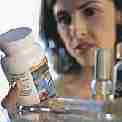Candida Summary
FEELING SICK AND TIRED OF FEELING SICK AND TIRED?
MAYBE IT’S A CANDIDA ALBICANS INTESTINAL YEAST INFECTION
And You Are Just 10 Minutes Away From Starting Your Cure
- Are you bothered by memory or concentration problems (brain fog) -- Feeling “spaced out”?
- Are your symptoms worse on damp, muggy days or in moldy places?
- Do you have nasal congestion or postnasal drip?
- Do you have a cough or recurrent bronchitis?
- Do you have attacks of anxiety or crying?
- Do you have a tendency to bruise easily?
- Do you have pain or muscle weakness?
- Does tobacco smoke really bother you?
- Do you get recurrent vaginal yeast infections? jock itch? athlete’s foot?
- Do you have dandruff?
- Do you feel fatigue or lethargy?
- Do you experience headaches?
- Do you have insomnia?
- Do you crave sugar? carbohydrates (the starches -- breads, pastas, potatoes, etc.)?
- Are you irritable?
Other Major Symptoms: Chronic Fatigue Syndrome, Fibromyalgia, Irritable Bowel Syndrome or other Digestive Disorders.
If you’ve answered “Yes” to some of these questions, you may have an intestinal overgrowth, or “Yeast” infection from Candida albicans (the infection is called Candidiasis -- can-duh-die’-a-sys).
“How did I get it?” -- Yeast is everywhere, and everyone has some in their system all the time, so all that has to happen for an overgrowth to occur is to give it a chance -- and it will grow like crazy. The most common enablers are:
- Taking antibiotics -- they kill off the “good” intestinal bacteria, and leave open space for yeast to grow.
- A high sugar or carbohydrate diet -- yeast feeds on sugar (it converts the sugar in grape juice and the carbohydrates in beer into alcohol). Carbohydrates are digested directly into sugar. Thus, a high sugar or carbohydrate diet provides yeast with all the fuel it can use to grow profusely.
- pH changes -- women are more susceptible than men because their monthly hormone cycles alter the body pH, providing a better environment for yeast to thrive.
“Is there science to back this up?” -- It’s been known now for about twenty years -- first popularized in 1983 in “The Yeast Syndrome” by Dr. John Parks Trowbridge, MD. The problem is that it has been notoriously hard to diagnose in any specific individual, consequently, most medical doctors considered it a fad diagnosis, and would not consider it seriously even though they have had numerous patients will the full spectrum of symptoms, and who weren’t getting any better. In the last few years some exotic medical tests have become available enabling a small but growing number of doctors to become convinced of the reality of Candida infections.
“If it’s in my intestines, why do I feed bad all over?” -- You feel bad all over because yeast kills their prey by poisoning them with a variety of very potent toxins and enzymes --the same way that snakes and spiders kill their prey. These toxins circulate in your blood, in effect, poisoning you all over. One of the features of these toxins is to kill immune system cells, making you less able to defend against a yeast infection, and making a yeast infection much harder to get rid of.
“How does this relate to allergies?” You’ve got a “Leaky Gut”. One of the reasons you feel so awful is because the yeast has penetrated through the intestinal wall, perforating it microscopically so that material from your intestinal tract “leaks” into the blood stream. This causes severe allergic responses and eventually breaks down the body’s ability to deal with these foreign agents, resulting in hypersensitivity. You are now in a negative spiral, with allergies further degrading the immune system and causing chronic problems like sinusitis and sinus infections, which in turn further weaken your immune system. You need to break this negative spiral.
“Is it hard to get rid of?” -- Candida is extremely hard to get rid of, because it doesn’t just live inside the intestines, but penetrates into the intestinal wall where it is protected from any agent that doesn’t get absorbed. Some popular treatments (ThreeLac, for instance) only target yeast living inside the intestinal tract. And it is important to kill them there. But if you don’t kill them in the intestinal wall, they just regrow back into the insides of the intestine. Our treatment programs target Candida everywhere it lives. It is important to understand that this is one of the most difficult infections to treat, and the cure takes a long time -- but it is possible if you follow the program.
““Do I have to follow a special diet? I see ads that say I don’t need to.” No matter what the ads say that you’ve been reading, it’s a really simple and straightforward issue: yeast lives on sugar -- the more sugar you feed them, the more they will grow and the harder they will be to kill. We’ve had any number of clients who had tried these “easy” cures for months, expensively and unsuccessfully, and then have come to us for a more systematic treatment program.
“What is your treatment program?” Our treatment program includes a number of natural herbal products that have been used for treating fungus and yeast infections for centuries. Fortunately, there is modern, scientific evidence to support the use of these remedies - some of the more exotic diagnostic medical lab tests compare the lethality of these medicines straight up against prescription anti-fungal drugs, so they are supported by hard science. And even more fortunately, they are available over-the-counter for self-treatment at home.
“Can’t I just go to a doctor and take a prescription drug?” -- Don’t we all wish it was so easy. Even if you were able to find a doctor, the bigger problem is that treatment and cure requires a comprehensive program -- there is no magic single pill.
Click here to continue to the Treatment Program page.




